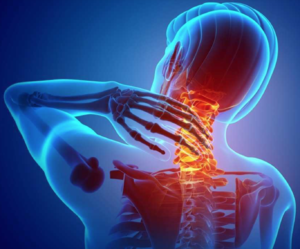An Overview of Neck Pain in Wheelchair Users
This page will be discussing Neck Pain (acute, sub-acute or chronic) with MSK characteristics as a result of becoming a wheelchair user. Discussing the prevalence, aetiology and management of this area. However, there is limited literature on this subject, the majority of literature discussed pain from patients' underlying conditions.
Wheelchair Users as a population[edit | edit source]
There are approximately 1.2million wheelchair users in the UK. There are a variety of different types of wheelchairs, such as self propelled, assistant propelled and Electric powered wheelchairs. Usage Varies from daily use to competitive use. (NHS England, 2014)[1]
Prevalence of Neck Pain in Wheelchair Users[edit | edit source]
General Pain in Wheelchair Users[edit | edit source]
A qualitative study interviewed 64 electric powered wheelchair users about their experiences of pain:
- 86% of participants experienced pain related to sitting in past or present wheelchairs
- 59% felt their pain was influenced by their Electric Powered Indoor/outdoor Wheelchair
- 17% reported experiencing severe pain
(Frank et al, 2014)[3]
Neck Pain in Wheelchair Users[edit | edit source]
A cross-sectional study with 68 participants recruited from the National Veteran's Wheelchair Games:
- 66% (n=45) reported neck/upper back pain at any time since they started using a wheelchair
(Bonger et al, 2003)[4]
A cross-sectional study with 750 participants conducted at 4 major Spanish hospitals offering education and training related to using a wheelchair permanently, either due to spinal cord injury or other reasons.
- 56% reported neck pain
(Kovacs et al, 2018)[5]
References[edit | edit source]
- ↑ NHS England. (2014). Improving Wheelchair Services. Available: https://www.england.nhs.uk/wheelchair-services/. Last accessed 22nd May 2019.
- ↑ http://masteringhealthhappiness.com/2017/06/27/easily-reduce-neck-pain-by-making-these-small-changes-to-your-daily-activities/
- ↑ Frank, A. De Souza, L. Frank, J. Neophytou, C. (2012). The pain experiences of powered wheelchair users. Disability and Rehabilitation . 34 (9), 770-778.
- ↑ Boninger, M.L., Cooper, R.A., Fitzgerald, S.G., Lin, J., Cooper, R., Dicianno, B. and Liu, B., 2003. Investigating neck pain in wheelchair users. American journal of physical medicine & rehabilitation, 82(3), pp.197-202
- ↑ Kovacs, F.M., Seco, J., Royuela, A., Barriga, A. and Zamora, J., 2018. Prevalence and factors associated with a higher risk of neck and back pain among permanent wheelchair users: a cross-sectional study. Spinal cord, 56(4), p.392.
Critical Appraisal[edit | edit source]
(Frank et al, 2014)[1] - This Paper included users who had been wheelchair users for 10 years before the interviews. However, it only interviewed wheelchair users who used Electric Powered Indoor/Outdoor Chairs (EPIOC) making it difficult to apply to other varieties of wheelchairs. Additionally, interviews were done over telephone eliminating the use of non-verbal communication making difficult to gain information from some participants who had communication difficulties. Furthermore, diagnostic data about participants was provided by the participants and not professional referrals. However, the authors stated that the participants were given appropriate diagnostic information by healthcare professionals. Lastly, this paper was aware of its limitations and provided a good analysis of qualitative data.
(Bonger et al, 2003)[2] - Crit App: Limited Sample size, not enough literature looking at neck pain with wheelchair users, included no inclusion or exclusion criteria
(Kovacs et al, 2018)[3] - Inclusion criteria, age >18 and permanent wheelchair user for more than >1 year. Exclusion criteria sing a wheelchair intermittently or temporarily, suffering from physical or mental inability, which made it impossible to respond to the interviewer’s questions (e.g., pentaplegia or senile dementia), reporting being unable to distinguish neuropathic from mechanical pain, presenting fever, and having been diagnosed (or being in the diagnostic process) of cancer, systemic infection, or any inflammatory diseases such as spondylitis or rheumatoid arthritis. Crit appraisal: strong robust methology, well defined exclusion and inclusion criteria







